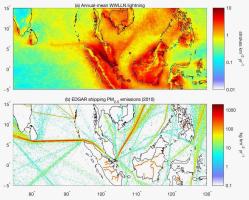 Apparently, lightning strikes twice as often over shipping sea lanes than over the ocean as a whole. Wired recently published an article about research that comes to that conclusion and suggests an answer to the question. They note that it might sound crazy, but it’s true: The heavens cast their wrath and fury on the ships more than on the fishes.
Apparently, lightning strikes twice as often over shipping sea lanes than over the ocean as a whole. Wired recently published an article about research that comes to that conclusion and suggests an answer to the question. They note that it might sound crazy, but it’s true: The heavens cast their wrath and fury on the ships more than on the fishes.
The article continues: A comparison of lightning strikes between 2005 and 2016 in the eastern Indian Ocean and South China Sea (above) and shipping emissions (below) shows a clear correlation between where humans sail and where lightning hits.
This may sound crazy—until you know a little bit about lightning. Under normal conditions, microscopic water droplets in the air grab onto “cloud condensation nuclei,” which are aerosol particles bigger than 50 nanometers, like a bit of dust, or sulfur dioxide. When few particles are present, each one picks up more droplets, and they coalesce into relatively short clouds at low altitudes. Those make rain. When a lot of aerosol particles are present, each one gets fewer droplets and can float high enough into the atmosphere to freeze. In the resulting tall clouds, those bits of ice and slush run into each other and transfer electric charges. The differences in charge create an electric field, which results in lightning.
So, the research suggests that pollution and particulates from ships burning dirty bunker fuel create clouds that cause lightning. Because ships travel the globe in well-defined sea lanes, these pollutants can become concentrated and result in more frequent lighting over sea lanes than over the ocean as a whole.
The lightning itself is not terribly dangerous. An average of around 27 people died from lightning strikes yearly over the last decade in the entire United States. There does not appear to be reliable data on how many sailors are killed by lightning strikes every year.
The good news is that the era of dirty bunker fuel may be coming to an end. Cleaner fuel should reduce the particulates which create clouds that trigger the lightning. It is a pity that we almost need to be struck by lightning to be reminded of why cleaner fuel matters.

I don’t suppose it could be that the people who report lighting strikes are in
those busy shipping lanes, while the vast, vacant reaches of the open sea are lonely places, uninhabited by human watchers.
Following the premise, I wonder that busy freeways and rail lines have also attracted Thor’s darts, especially back in the coal burning era and sooty diesel trucks. Should Airports have been a playground for sparklers
when jets spewed their brownish trails?
And again, when coal, wood and peat were primary fuels, was London a
prime spot for Lightning watchers? I wonder.
Like active volcanos, friction of the dust/Ash clouds causes static, then you get static-discharge AKA lightning.
Observations here are via a receiver network on VLF radio, Dick.
See the research paper (which awesomely enough is open access, not paywalled):
https://agupubs.onlinelibrary.wiley.com/doi/full/10.1002/2017GL074982
Here’s the receiver network:
http://wwlln.net/
“We hypothesize that emissions of aerosol particles and precursors by maritime vessel traffic lead to a microphysical enhancement of convection and storm electrification in the region of the shipping lanes.”
The problem with hypothesys is when people pass them off as proven fact. A hypothesy is some ones learned guess at what is going on and may have been dismissed by the scientific community.
Until then the article is mostly conjecture that shouldnt be published as fact. As there are many other things out there that are also known as “fake news”. At least the article https://agupubs.onlinelibrary.wiley.com/doi/full/10.1002/2017GL074982 states it is only a hypothesy.
Doug,
I’ve been listening ti VLF and S/W since I was a kid some 60+ years ago, that lead to my HAM ticket in 1975.
Well, it’s incumbent on critics (in the scientific community at least) to offer a superior alternative hypothesis to one that is presented with reasonable supporting information. Until that happens, the hypothesis stands.
So we could start by asking “which part of the article is conjecture?”
The article’s hypothesis of course is conjecture, but conjecture comes in different qualities. I could conjecture that water boils at 50C at sea level pressure, but that conjecture wouldn’t be supported by observation or experiment.
For the paper in question, conjecture starts with expectations borne of known principles, principles that lead to an expected outcome. What alternative hypothesis would explain how a observed promotion of lightning discharges is associated with shipping lanes and observed prevalence of compounds that would, a combination we can fully expect given what we already know about lightning?
The thing is, at the end of the day “I doubt it” isn’t an argument. 🙂